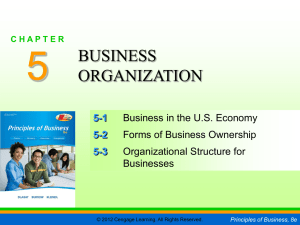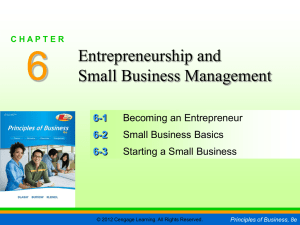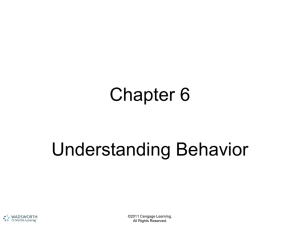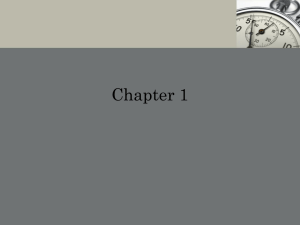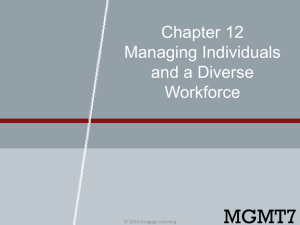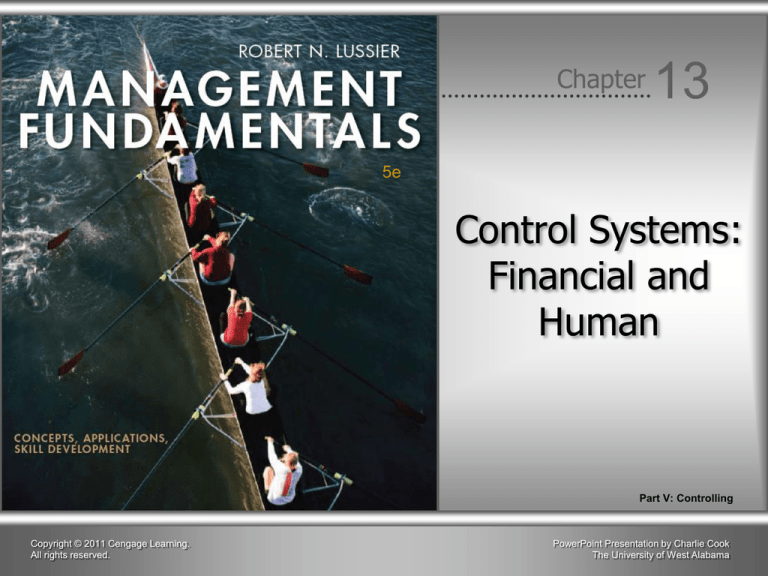
Chapter
13
5e
Control Systems:
Financial and
Human
Part V: Controlling
Copyright © 2011 Cengage Learning.
All rights reserved.
PowerPoint Presentation by Charlie Cook
The University of West Alabama
Learning Outcomes
After studying this chapter, you should be able to:
1.
List the four stages of the systems process and describe the type
of control used at each stage.
2.
Describe the appropriate feedback process within and between
the functional areas/departments.
3.
List the four steps in the control systems process.
4.
Describe the differences among the three categories of control
frequency.
5.
Explain how the capital expenditures budget is different from the
expense budget.
6.
List the three primary financial statements and what is presented
in each of them.
Copyright © 2011 Cengage Learning. All rights reserved.
13–2
Learning Outcomes (cont’d)
After studying this chapter, you should be able to:
7.
Explain the importance of positive motivational feedback in
coaching.
8.
Explain the manager’s role in counseling and the role of the
employee assistance program staff.
9.
Define the key terms listed at the end of the chapter.
Copyright © 2011 Cengage Learning. All rights reserved.
13–3
IDEAS ON MANAGEMENT
at The Ranch Golf Club
1.
How does The Ranch control the organizational system?
How does The Ranch control the functional systems?
2.
How does The Ranch use the control systems process, and
how is it performing?
3.
What control methods are used to achieve objectives and
standards at The Ranch?
4.
What are the major operating budget revenues and expenses
at The Ranch?
5.
How does The Ranch use capital expenditure budgets?
How does The Ranch use financial statements and budgets?
6.
Does Peter Clark coach his Jiffy Lube business, The Ranch,
and sports teams the same way?
7.
How does The Ranch get feedback to improve performance?
Copyright © 2011 Cengage Learning. All rights reserved.
13–4
Exhibit 13–1 ● The Systems Process with Types of Controls
Copyright © 2011 Cengage Learning. All rights reserved.
13–5
Organizational Systems Controls
• Controlling
The process of establishing and implementing
mechanisms to ensure that objectives are achieved.
• Preliminary Control (Feedforward Control)
Controls designed to anticipate and prevent possible
problems (e.g., preventive maintenance)
Planning and organizing are important control
functions.
Standing plans for recurring situations
Contingency plans for probable events
Copyright © 2011 Cengage Learning. All rights reserved.
13–6
Organizational Systems Controls (cont’d)
• Concurrent Control
Action taken to ensure that standards are met
as inputs are transformed into outputs.
• Rework Control
Action taken to fix an output.
• Damage Control
Action taken to minimize negative impacts on
customers/stakeholders due to faulty outputs.
• Feedback
Information about outputs from customers and
stakeholders.
Copyright © 2011 Cengage Learning. All rights reserved.
13–7
Copyright © 2011 Cengage Learning. All rights reserved.
13–8
Exhibit 13–2 ● Systems Processes for Functional Areas/Departments
Copyright © 2011 Cengage Learning. All rights reserved.
13–9
Exhibit 13–2 ● Systems Processes for Functional Areas/Departments (cont’d)
Copyright © 2011 Cengage Learning. All rights reserved.
13–10
Exhibit 13–3 ● The Feedback Process between
Functional Areas/Departments
Copyright © 2011 Cengage Learning. All rights reserved.
13–11
Exhibit 13–4 ● The Control Systems Process
Balanced Standards:
• Quantity
• Quality
• Time
• Cost
• Behavior
Identify Critical
Success Factors
(CSFs)
Copyright © 2011 Cengage Learning. All rights reserved.
13–12
Exhibit 13–5 ● Operations Performance Report
Copyright © 2011 Cengage Learning. All rights reserved.
13–13
Join the Discussion
Ethics & Social Responsibility
• Academic Grades
1. Why are professors giving higher grades today than
were given 5, 10, or 20 years ago?
2. Are students who are putting in less time and getting
higher grades being well prepared for a career with
high standards after graduation?
3. Is it ethical and socially responsible for professors to
drop standards and for colleges to award higher
grades today than they did 5, 10, or 20 years ago?
4. Should colleges take action to raise standards? If so,
what should they do?
Copyright © 2011 Cengage Learning. All rights reserved.
13–14
Join the Discussion
Ethics & Social Responsibility
• Academic Grades (cont’d)
5. An important part of a professor’s job is to evaluate
student learning through grading. Do you believe
your learning is evaluated effectively? How could it
improve?
6. Do you find consistency among your professors’
standards in terms of the work required in their
courses and the grades given, or do some
professors require a lot more work and some give
lots of As and others lots of lower grades? Should
colleges take action to improve consistency among
professors’ standards? If so, what should they do?
Copyright © 2011 Cengage Learning. All rights reserved.
13–15
Exhibit 13–6 ● Types, Frequency, and Methods of Control
Copyright © 2011 Cengage Learning. All rights reserved.
13–16
Copyright © 2011 Cengage Learning. All rights reserved.
13–17
Exhibit 13–7
Steps in the
Master Budgeting
Process
Copyright © 2011 Cengage Learning. All rights reserved.
13–18
Budgeting as a Preliminary Control
• Budget
A pro forma (planned) statement of the quantitative
allocation of resources for specific activities.
• Operating Budget
Revenue Budget
Forecast of total income for the year.
Expense Budget
Forecast of total operating spending for the year.
• Capital Expenditures Budget
All planned expenditures for major asset investments.
Copyright © 2011 Cengage Learning. All rights reserved.
13–19
Join the Discussion
Ethics & Social Responsibility
• Expenses
1. Is it ethical and socially responsible for
PricewaterhouseCoopers to charge the full rate for
travel expenses when it gets discounts?
2. If you worked for a company and knew it did this,
would you say anything to anyone about it?
If yes, to whom would you speak and what would
you say?
Copyright © 2011 Cengage Learning. All rights reserved.
13–20
Financial Statements as Rework Controls
• Income Statement
Presents revenues and expenses and the profit or
loss for the stated period of time.
• The Balance Sheet
Presents the assets and liabilities and owners’ equity
for the stated period of time.
• Cash Flow Statement
Presents the cash receipts and payments for the
stated time period.
Copyright © 2011 Cengage Learning. All rights reserved.
13–21
Exhibit 13–8 ● IBM Financial Statements (in millions)
Copyright © 2011 Cengage Learning. All rights reserved.
13–22
Human Controls
• Coaching
The process of giving motivational feedback to
maintain and improve performance.
• The Importance of Positive Feedback
• Management by Walking Around (MBWA)
Listening rather than talking
Teaching rather than telling
Facilitating rather than ordering
Copyright © 2011 Cengage Learning. All rights reserved.
13–23
Exhibit 13–9 ● Coaching Model
Copyright © 2011 Cengage Learning. All rights reserved.
13–24
Job Performance: “Can Do” and “Will Do”
• Types of Problem Employees
1. Employees who do not have the ability to meet the
job performance standards.
2. Employees who do not have the motivation to meet
job performance standards.
3. Employees who intentionally violate standing plans.
4. Employees with problems.
Copyright © 2011 Cengage Learning. All rights reserved.
13–25
Human Controls (cont’d)
• Counseling
Dealing with problem employees by attempting to
help solve the problem.
• Management Counseling
Giving employees feedback so they realize that a
problem is affecting their job performance.
Referring employees with problems to employee
assistance programs.
• Employee Assistance Program (EAP)
A staff of people who help employees get
professional assistance solving their problems.
Copyright © 2011 Cengage Learning. All rights reserved.
13–26
Exhibit 13–10 ● Problem Employees
The late employee
The absent employee
The dishonest employee
The violent or destructive employee
The alcoholic or drug user
The nonconformist
The employee with a family problem
The insubordinate employee
The employee who steals
The sexual or racial harasser
The safety violator
The sick employee
The employee who’s often socializing or doing personal work
Copyright © 2011 Cengage Learning. All rights reserved.
13–27
Disciplining
• Discipline
Corrective action to get employees to meet standards
and standing plans.
To change ineffective employee behavior.
To let employees know that action will be taken when
standing plans or performance requirements are not met.
To maintain authority when challenged.
Progressive discipline steps
Oral warning, written warning, suspension, and dismissal.
Documentation must be maintained.
Copyright © 2011 Cengage Learning. All rights reserved.
13–28
Exhibit 13–11 ● Guidelines for Effective Discipline
A. Clearly communicate the standards and standing plans to
all employees.
B. Be sure that the punishment fits the crime.
C. Follow the standing plans yourself.
D. Take consistent, impartial action when the rules are broken.
E. Discipline immediately, but stay calm and get all the
necessary facts before you discipline.
F. Discipline in private.
G. Document discipline.
H. When the discipline is over, resume normal relations with
the employee.
Copyright © 2011 Cengage Learning. All rights reserved.
13–29
Copyright © 2011 Cengage Learning. All rights reserved.
13–30
Join the Discussion
Ethics & Social Responsibility
• Disciplining Ethical Behavior
1. Have you ever been in or known of a situation in
which people were rewarded for being unethical and
disciplined for being ethical? If so, describe the
situation.
2. Is it ethical and socially responsible for firms to
establish controls that reward unethical behavior and
discipline ethical behavior to make more money?
Copyright © 2011 Cengage Learning. All rights reserved.
13–31
Exhibit 13–12 ● The Discipline Model
1. Refer to past feedback
2. Ask why the undesired
behavior was used.
3. Give the discipline.
4. Get a commitment to change
and develop a plan.
5. Summarize and state
the follow-up.
Copyright © 2011 Cengage Learning. All rights reserved.
13–32
KEY TERMS
•
•
•
•
•
•
•
•
•
•
budget
capital expenditures budget
coaching
concurrent control
control frequency
control systems process
controlling
critical success factors
damage control
discipline
Copyright © 2011 Cengage Learning. All rights reserved.
• employee assistance
program (EAP)
• financial statements
• management audit
• management by walking
around (MBWA)
• management counseling
• operating budgets
• preliminary control
• rework control
• standards
13–33



